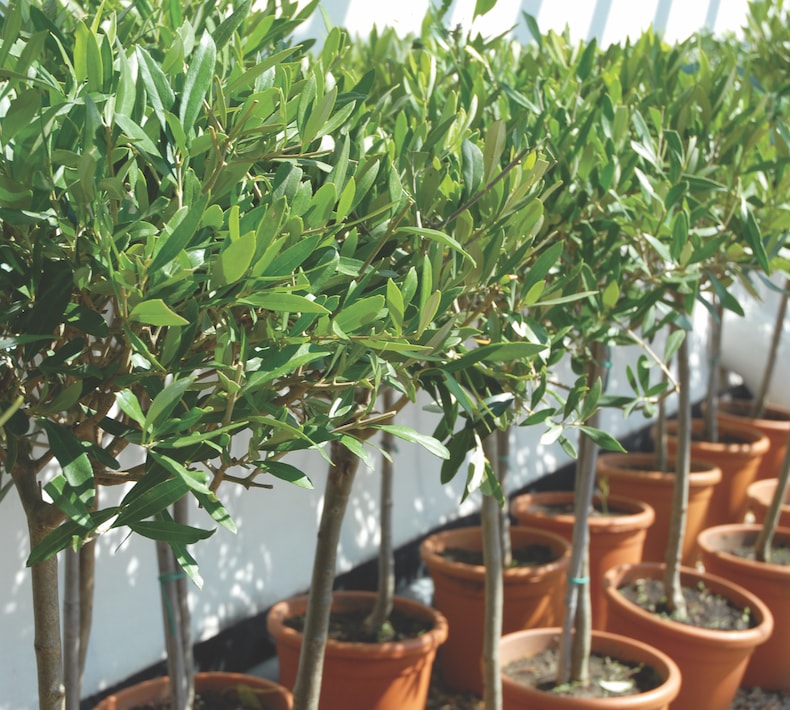
How to prune olive trees
Olive trees are very slow-growing and require little pruning in their early years - in fact leaving them alone at this stage helps to produce a stronger and healthier specimen. Once your tree is a few years old, carefully thinning it out allows more light to penetrate and, in warmer parts of the UK, fruit to develop. Here's our horticultural team's advice on how and when to prune an olive tree.
Order an olive tree now for convenient, doorstep delivery.
When to prune an olive tree

Remove unproductive branches to encourage new growth
Image: Standard Olive tree from Thompson & Morgan
Always prune your olive tree in late spring or early summer. This is also the best time to thin out any crowded branches and allow as much light as possible into the centre of the tree. Make sure there’s no chance of frost before you start.
Olives grown in containers may need to be lightly pruned again later in the summer to keep their size in check. Once they reach their optimum height, pinch out the tips to encourage branching.
How to prune your olive tree
The ideal shape for an olive tree is that of a wine glass, with three to four main branches opening from the main trunk. To encourage a young tree to develop a good shape, wait until your olive reaches about 1.5m in height before choosing three or four strong, well-placed shoots to form the main framework. Pinch out the others.
More established trees should have any dead or damaged shoots removed each spring, along with any branches that spoil the shape. Go gently - pruning too hard will produce lots of vertical water shoots which divert strength away from the main tree.
Established olive trees require very little maintenance other than a light prune to allow as much light as possible to reach the centre. Pruning is necessary if you want your tree to fruit, but if this isn’t important, you can safely leave your olive tree to its own devices for years at a time.
Visit our comprehensive hub page for info and expert advice on growing specimen and hedging trees.
See all pruning guides
Individual guides
Flower & Shrubs
- Pruning Buddleja
- Pruning Camellias
- Pruning Clematis
- Pruning Fuchsias
- Pruning Hydrangeas
- Pruning Hypercium - St Johns Wort
- Pruning Lavender
- Pruning Magnolias
- Pruning Passion Flowers
- Pruning Rhododendron
- Pruning Ribes Sanguineum
- Pruning Rosemary
- Pruning Roses
- Pruning Tree Peonies
- Pruning Wisteria
- Pruning Asparagus
- Pruning Blueberries
- Pruning Goji Berries
- Pruning Honeyberries
- Pruning Raspberries
- Pruning Apple trees
- Pruning Box and Yew trees
- Pruning Catalpa trees
- Pruning Christmas trees
- Pruning Patio Fruit trees
- Pruning Pear trees
- Pruning Plum trees
Fruit & Veg
Trees

Written by: Sophie Essex, garden writer
Sophie Essex is a freelance garden writer with a passion for horticulture and environmental conservation. With a BSc in Botany/Plant Biology from the University of Plymouth, she further honed her expertise through a Masters of Science in Biodiversity and Taxonomy of Plants from The University of Edinburgh. Sophie has also worked as a professional gardener and landscaper, showcasing her practical skills by transforming outdoor spaces. Her commitment to fieldwork is further evident in her acquisition of a Certificate in Field Botany from the Royal Botanic Garden Edinburgh, and over the years, she has interned at the Eden Project, Cornwall, the National Trust for Scotland and the Royal Botanic Garden Edinburgh.Banner image: Peter Turner Photography/ Shutterstock
Sign Up For Exclusive Special Offers




© 2025 Thompson & Morgan. All rights reserved. A division of Branded Garden Products Limited.



